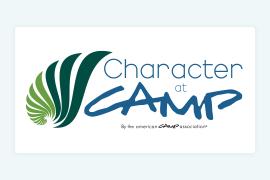Imagine taking a prospective family on a tour of your wholesome, backto- nature camp. You lead them down a dirt path, over a log bridge, and along the lake's edge on a route that also includes a visit to a pink- and red-striped candy shop, a purple pizza joint, an ice cream parlor shaped like an ice cream cone, and a spherical video store . . . all on your camp grounds. Wholesome? Back-to-nature? Is that an airstrip over there? Such is the tour route when an inventive and inexpensive program activity is a hit with campers, staff, and visitors. The unexpected landscape is the result of all ages of a camp community transforming simple rocks with paint, woodfiller, and endless imagination into a rock town. And . . . shhhh, don't tell the campers . . . the popular summer camp project could be straight out of a creative social studies curriculum.
Four summers ago at Camp Pemigewassett, amid the hubbub of opening day, a new camper's parents had just departed and "Sam" (not his real name) was on the verge of dissolving. We sat side-by-side on a grassy slope, and though fighting back tears, Sam was willing to answer simple questions and eventually engage in conversation. In time, it emerged that his favorite subject in school was art. I'd recently purchased Painting Houses, Cottages and Towns on Rocks by artist Lin Wellford, but wasn't convinced that our campers, boys ages eight to fifteen, would find the activity as charming as I did. I asked Sam what he thought; would he be interested in painting a rock to look like . . . a hobbit house . . . perhaps? His puffy eyes widened a bit, and he nodded with genuine enthusiasm.
In a continuing effort to keep homesickness at bay, Sam and I grabbed the moment and headed to the art building, stopping along the way to collect a couple of softballsized rocks. Out came the colorful acrylic paints, in joined a gang of curious campers, and together, unknowingly at the time, we founded the first town of "Pemi Rocks." Each summer since, we've started a new settlement in June, expanding it over the next seven weeks to a community of eighty to one hundred rocks until camp closes in August. At that time, the town is disbanded, and most of the rocks are taken home for the winter — to perch on shelves, in kitchen windows, or on stacks of paper — as solid reminders of a summer gone by.
Rock-painting can serve as a weekly instructional activity, a daily sign-up activity, or as "open art" during afternoons, and is an ideal rainy-day project. It is especially popular among our younger boys (ages eight to eleven), though many an older camper and counselor have joined in, adding yet another dimension to the developing community. Staff members cut roofing-shingles into strips and rectangles that campers arrange into road systems and parking lots. Curved shingle strips are spray-painted royal blue, and when placed end-to-end, flow together into meandering rivers and streams. As time goes by, bridges emerge, as do fences, telephone poles, cars, and street signs; all of which are fabricated out of other rocks, branches, pinecones, and most of all, boundless imagination. Some boys prefer to hunt for rocks, others to paint them, others to do the urban planning. There's room for all skill levels and interests, and flexibility to participate once or many times.
Painting Houses, Cottages and Towns on Rocks offers both written and visual step-by-step tips on transforming everyday rocks into clever artwork. While many boys rely on Wellford's instructions, other budding architects and designers recognize the infinite possibilities for personal expression and paint unique structures, some less conventional than others. We start each session visiting the town to collaboratively decide what the town needs . . . "a hospital," "a school," "a hotel," "a candy shop," "another candy shop!" As days and weeks go by, more "houses" and "businesses" are added, spreading out from a central core.
The most meaningful by-product of the activity, however, is the conversation that takes place among the participants, young and old. As boys paint a school or hospital, for instance, they naturally share personal stories and opinions, getting to know one another better through the process ("My history teacher once told me . . ." and "Have you ever gotten stitches?"). Settle in for a long afternoon of animated debate should someone recognize that every town needs a sports stadium.
Your camp season and session lengths will determine if you create one town or multiple towns, and how they grow. Camp Pemi offers a full session of seven weeks and two three-and-a-half-week sessions, so mid-July brings about gaping holes in our town, as first-session boys take home their creative efforts. These empty lots are soon filled over the next two weeks by newly-painted rocks, but at this point, anticipation begins to build for our big move.
Camp Pemi hosts an end-of-year art show during the final week of camp. The inside of our library is transformed into an art gallery, with bookshelves and tables draped in black fabric to showcase the campers' 2D and 3D creative efforts. The annual event provides the opportunity for our rock-painting community to put in some heavy lifting as we relocate our rock town from outside the art shop, where it has grown over the course of the summer in a haphazard and spontaneous fashion, to its new location on the grassy lawn in front of the library, where it provides a colorful welcome to the art show.
Perhaps more importantly, the relocation allows us to reassemble the town with purpose and forethought. Each camper draws upon knowledge and close observation of his own hometown or city, not just to imagine what types of buildings there are — as he did when considering what to paint his rock — but where those buildings are located and why. A shift in thinking takes place: from town father to urban planner. Boys who typically might balk at having to pick up a pair of socks are eager to carry multiple armloads of painted rocks to a staging area as they discuss questions such as: "What is typically in the center of a town? Where are homes usually located? Where would a post office be, or an airport?" With an overall plan and sense of organization in mind, the boys get to work. They position the royal blue rivers, streams, and lakes first, establish the town center, and then arrange the town's road system. Finally the eighty to one hundred rocks are placed throughout the new town, this time with an informed sense of location and logical consideration.
The tangibles are paint, rocks, shingles, and brushes. The intangibles are collaborative decision making, stewardship of place, creative expression, reasoning and communication skills, and unplugged imaginative play. Campers come to recognize the interrelatedness of people, topography, and structures within communities as they position their "houses" along the river, and the "library" in the center of town. They even find ways to express opinions on sustainability and ethics, as was the case when one camper painted a blue and gold Walmart to anchor the outskirts of our "Pemi Rocks" town. His nine-year-old friend countered with a painted rock positioned across the street: a sign that simply stated, "Buy Local."
Finally, while most campers take their personally-painted rocks home at the end of August, several always ask if they can store their rocks in the art shop over the winter, where, come next June, they can be pulled out into the sunshine to launch the next town of Pemi Rocks. In building a community, they become a community, working together in the present and keeping an eye on the future.
Basic Supplies for Creating a Rock Town in Your Camp
Reference
Wellford, L. (1996). Painting houses, cottages and towns on rocks. Iola, WI: North Light Books.
Dottie Reed has spent the last twenty-three summers at Camp Pemigewassett in New Hampshire, a residential camp for boys ages eight to fifteen, founded in 1908. Though now working year-round for Camp Pemi in an administrative capacity (and teaching art activities during the summer), Dottie previously worked for Dickinson College as a graphic designer and for the college museum's Outreach Program, where she helped design educational programming for school groups that incorporate state academic standards into hands-on, interactive programs. E-mail the author at [email protected].
Originally published in the 2010 July/August issue of Camping Magazine.


